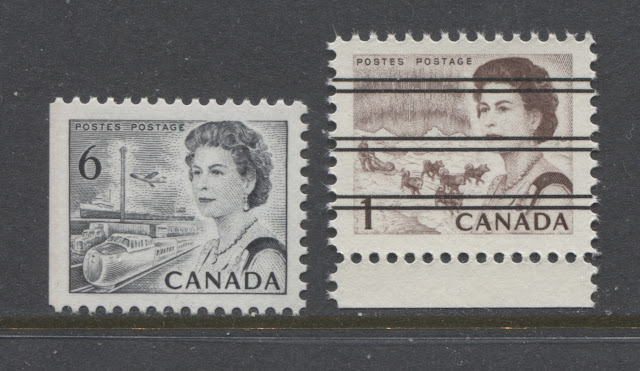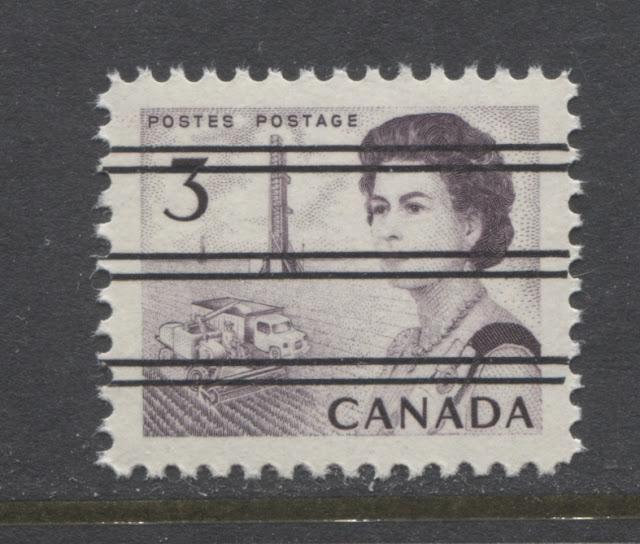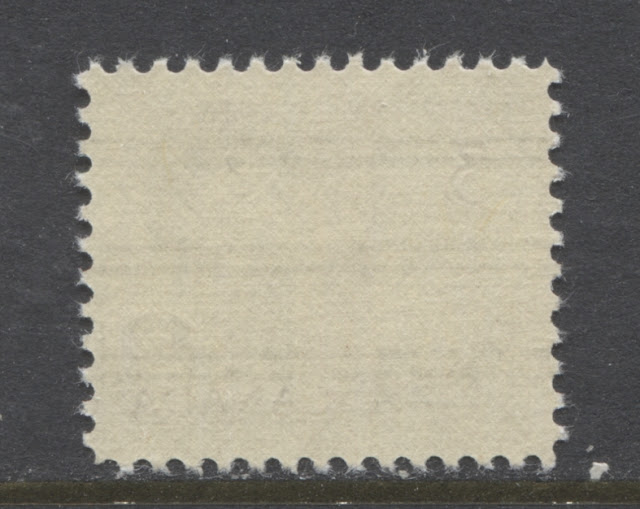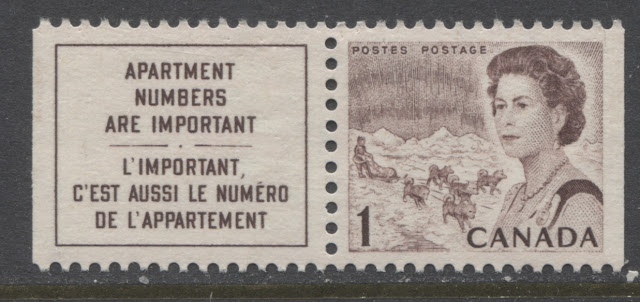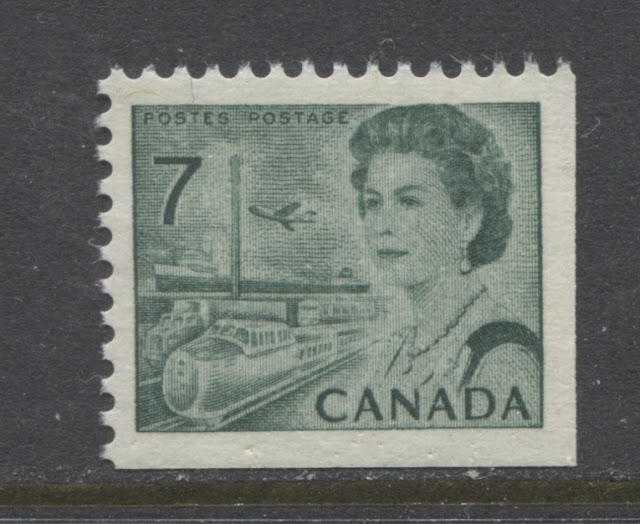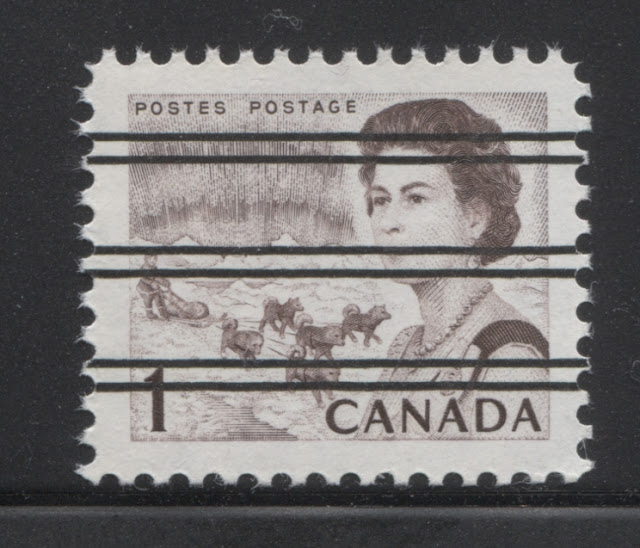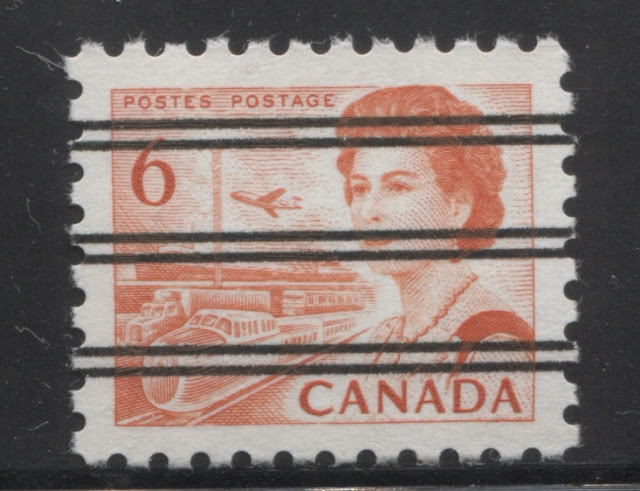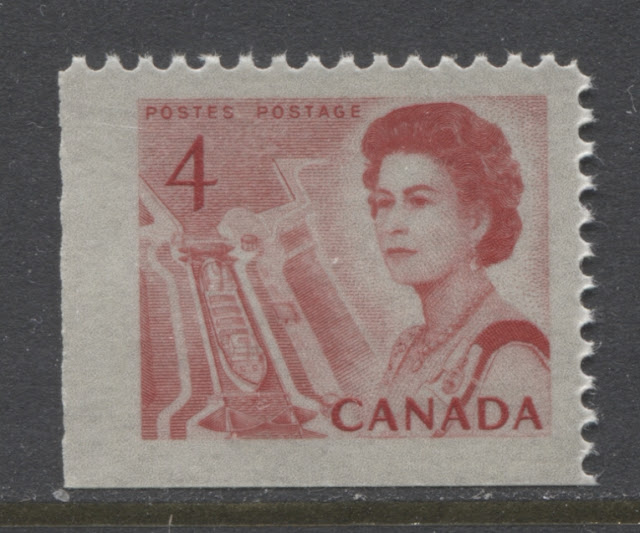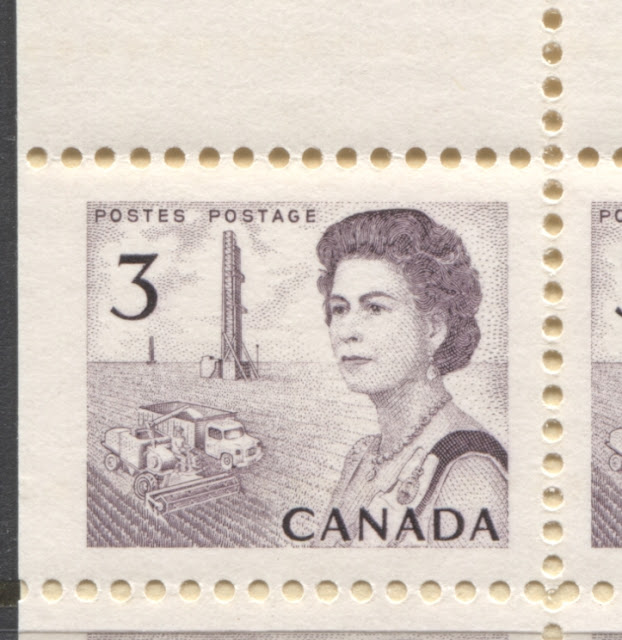Overview
Today's post will deal with what is perhaps the most complicated topic of all, as far as this issue is concerned: the paper used to print the stamps. Much attention has been paid to the fluorescence of the paper, which is to say the appearance of the paper when placed under a long-wave ultraviolet lamp. However, there are other attributes of the paper that are important, and worthy of detailed study as well. These include:
1. The thickness of the paper.
2. The whiteness of the paper when viewed in normal light.
3. The direction of the paper weave: i.e. horizontal versus vertical.
4. The texture of the paper on both the front and the back - i.e. smooth versus ribbed.
5. The surface porosity of the paper - porous and soft, versus coated and non-porous.
6. The opacity of the paper.
7. The surface finish - whether or not the paper is matte unsurfaced, or glazed.
This post will discuss all of these attributes in detail as well as covering the topic of paper fluorescence. Keen specialists will notice that the papers used by the Canadian Bank Note Company (CBN) are different from the papers used by the British American Bank Note Company (BABN).
I will start with a general discussion of each attribute, and then I will attempt to illustrate the various paper types, grouped according to printer. Today's post will be the general discussion of the attributes other than fluorescence. Next week I will devote an entire post to the topic of paper fluorescence on this issue. Finally, the following week I will write about each of the specific paper types found on this issue.
Paper Thickness
Most of the papers hover around the same general thickness, which on average, is between 0.003" and 0.0035". However, there are a few stamps that are notably thinner or thicker than this. Significant variations tend to suggest an altogether different paper.
Whiteness Of The Paper in Normal Light
There are notable differences between the appearance of several papers when viewed in normal light, with some of the papers appearing to be a distinct cream, off-white colour, while others are notably white. Usually, but not always, the appearance of the paper will correspond to the fluorescence level, with the cream papers being at the dull end of the scale, and the white papers being at the higher end of the scale. Sometimes though, a paper that appears quite white in normal light, can appear dull or dead under ultraviolet light, and other times there are highbrite papers that do not appear to be overly white in normal light.
These differences are to be found with the papers used by both printers, as we shall see.
The scan below shows an example of the difference I am talking about:
Direction Of The Paper Weave
The direction of the paper weave is another attribute that shows very clear differences on this set, and this aspect of the paper is often overlooked by collectors, as it is not always obvious. On the stamps that have dextrose gum, where the paper tends to curl from the gum, the direction of the curl gives a clear indication of the weave direction:
Here is an example of the 6c CBN printing on vertical wove paper that shows horizontal ribbing on the face:
Here the ribbing is quite distinct, but on some stamps it can be quite hard to see. The easiest way to see it is to tilt the stamp at a 20 degree angle, toward the light, rather than a 45 degree angle. The light will reflect off the surface of the paper in a way that will make the ribbing easy to see.
Here is another example on the 2c green plate 2 block from the lower left position:
Here you can see that the ribbing is even more pronounced than on the 6c above.
The vertical ribbed paper that is often found on the booklet stamps and some of the sheet stamps printed by the BABN is a bit more subtle, but an example taken from the 25c booklet containing the 1c, 3c and 7c is shown below:
The ribbing on this example is hard to see, but if you look at the white background of the label, you can just make it out in places. This is also a good example of a BABN paper that is clearly cream in appearance, rather than white. The ribbing is usually visible under magnification and shows up as a corrugated surface that runs in the vertical direction, whereas this texture does not appear on unribbed stamps, even when such stamps are viewed under high power magnification.
This scan shows another type of paper that is often found on the booklet stamps printed by the BABN. It is characterized by indents in the surface, that give it a pebbly appearance. If you look in the lower margin, you can see several of these indents. They do not occur across the entire surface of the stamp, but rather in a haphazard pattern, so that there will be some parts of the stamp that are smooth. However, there will always be some part of the stamp that will show these indents.
Surface Porosity
The paper of the stamps printed by the CBN on both the high and the low values, generally has a smooth appearance under magnification, but there are usually some very fine spots of unevenness in the paper as well as fine pores visible, such as in the following two stamps:
This stamp is on paper with dextrose gum. As you can see, it has a relatively smooth appearance, but if you look very closely in the upper margin and the other margins, you can see the very fine pores. If you view the stamp at an angle to the light, it will have a surface sheen, but when viewed straight-on, it is clear that the paper has not been coated on the surface, but has merely been smoothed.
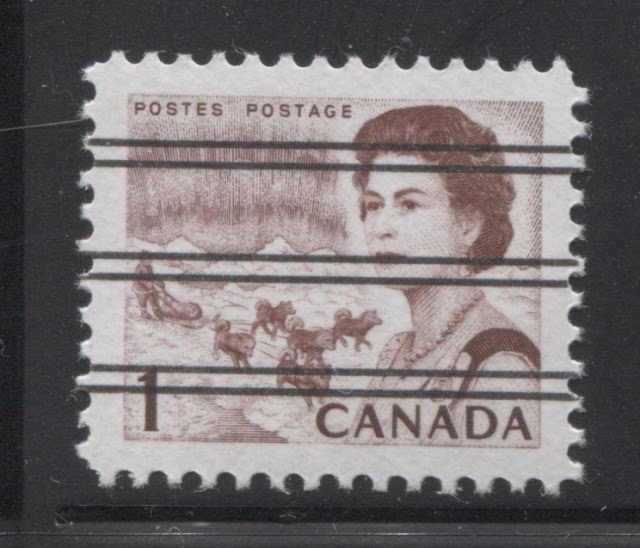
This stamp is on paper with PVA gum. The pores are still visible if you look hard enough, but they are not as obvious as on the previous dextrose gum stamp. On most of the high value stamps printed on paper with PVA gum, the surface is very smooth, with only a few very fine pores visible. Other times a very light horizontal ribbing can be seen under magnification, but not at all when the stamps are viewed normally.
Then there are some stamps printed on paper with dextrose gum that had a coating applied to the paper. Usually this coating rendered the stamps completely non-reactive to UV light. However, stamps printed on this paper have a perfectly smooth surface, with few to no pores visble. The following is an example of the 1c printed on this type of paper:
Contrast the appearance of the margins of this stamp with the first 1c stamp shown above. It may take a few long glances for you to see the difference, but once you see it, it is very obvious.
The paper on the BABN stamps is much more porous than that used for the CBN stamps, with the paper appearing to be much softer. The scan below shows an example of the 6c orange, showing the high porosity of the paper:
If you look at the margins around the stamp you can see a lot of pores.
Opacity
The paper on more or less all of the stamps of this issue is generally opaque in the sense that if you view the stamps from the back you will not be able to see any part of the design through it. If you lay the stamps face-up on a black background, the margins will appear creamy or white, depending on the paper colour, but you will not see any of the black background showing through.
There is one exception though that I discovered by accident when going through a lot of unopened booklets. There was a 25c stapled booklet containing panes of the 1c and 4c, where the panes were printed on oily paper. An example of a 4c stamp from that booklet is shown below:
I had considered the possibility that these were simply panes that had oil spilled on them. However, the staple on the booklet was the right width and showed no sign of any disturbance, and there were no oil stains on the booklet covers, or any of the interleaf pages, which one would expect there to be if oil had been spilled on it. My conclusion is that this is indeed another type of paper that must have been used for a very short run of these.
Surface Finish
As explained above, most stamps are printed on uncoated paper, which has been smoothed into a very fine finish, but there is no shine to either the coated, or the uncoated paper unless the stamps are tilted and viewed at an angle to the light.
However, there was one printing of the 2c and 3c that was made for inclusion in the 25c booklets that were produced for the OPAL manufacturing Co. in Toronto. The paper used for these stamps has a very glossy surface coating that is visible, even when the stamps are not viewed at an angle to the light. It is very distinct, and the colours of both stamps are quite unlike anything that is usually seen on this issue.
An example of the 3c purple from this printing is shown below, along with part of the unprinted gutter that came in the booklet:
This concludes my discussion of the attributes of paper other than fluorescence. Next week's post will discuss paper fluorescence in depth, and then the following week, I will look at the specific paper types found on this issue and describe them in terms of the various attributes that have been discussed here.
Today's post will deal with what is perhaps the most complicated topic of all, as far as this issue is concerned: the paper used to print the stamps. Much attention has been paid to the fluorescence of the paper, which is to say the appearance of the paper when placed under a long-wave ultraviolet lamp. However, there are other attributes of the paper that are important, and worthy of detailed study as well. These include:
1. The thickness of the paper.
2. The whiteness of the paper when viewed in normal light.
3. The direction of the paper weave: i.e. horizontal versus vertical.
4. The texture of the paper on both the front and the back - i.e. smooth versus ribbed.
5. The surface porosity of the paper - porous and soft, versus coated and non-porous.
6. The opacity of the paper.
7. The surface finish - whether or not the paper is matte unsurfaced, or glazed.
This post will discuss all of these attributes in detail as well as covering the topic of paper fluorescence. Keen specialists will notice that the papers used by the Canadian Bank Note Company (CBN) are different from the papers used by the British American Bank Note Company (BABN).
I will start with a general discussion of each attribute, and then I will attempt to illustrate the various paper types, grouped according to printer. Today's post will be the general discussion of the attributes other than fluorescence. Next week I will devote an entire post to the topic of paper fluorescence on this issue. Finally, the following week I will write about each of the specific paper types found on this issue.
Paper Thickness
Most of the papers hover around the same general thickness, which on average, is between 0.003" and 0.0035". However, there are a few stamps that are notably thinner or thicker than this. Significant variations tend to suggest an altogether different paper.
Whiteness Of The Paper in Normal Light
There are notable differences between the appearance of several papers when viewed in normal light, with some of the papers appearing to be a distinct cream, off-white colour, while others are notably white. Usually, but not always, the appearance of the paper will correspond to the fluorescence level, with the cream papers being at the dull end of the scale, and the white papers being at the higher end of the scale. Sometimes though, a paper that appears quite white in normal light, can appear dull or dead under ultraviolet light, and other times there are highbrite papers that do not appear to be overly white in normal light.
These differences are to be found with the papers used by both printers, as we shall see.
The scan below shows an example of the difference I am talking about:
If you look at the above two stamps, you can see very clearly that the paper of the right hand stamp is cream, as opposed to white. The stamp on the left is clearly white - not a very bright white mind you, more of a greyish white, but clearly not cream. The hibrite paper used by the BABN is much brighter than this, appearing very bright white in normal light.
Direction Of The Paper Weave
The direction of the paper weave is another attribute that shows very clear differences on this set, and this aspect of the paper is often overlooked by collectors, as it is not always obvious. On the stamps that have dextrose gum, where the paper tends to curl from the gum, the direction of the curl gives a clear indication of the weave direction:
- If the paper curls from side to side, then the paper is vertical wove.
- If the paper curls from top to bottom, then the paper weave is horizontal.
Where the stamps do not curl, which is all the stamps with PVA gum, the only way to tell for sure which direction the weave of the paper is in is to take the stamp very gently between your thumb and index finger and bend it very gently from side to side, and then from top to bottom. Whichever direction offers the least amount of resistance, i.e. whichever direction is the easiest to bend is the direction of the weave. So stamps on vertical wove paper will bend easily from side to side, while those on horizontal wove paper will bend easiest from top to bottom.
Often the paper will show a visible mesh that appears to run in either the horizontal or vertical direction. Interestingly, this mesh usually runs in the opposite direction to the actual direction of the weave, so that horizontal wove stamps often have vertical mesh, while those stamps on vertical wove paper have mesh that runs in a horizontal direction. The CBN stamps with PVA gum, which are usually on vertical wove, will usually show a very fine vertical mesh when viewed against a good strong backlight.
The stamps printed by CBN with dextrose gum are usually printed on vertical wove paper for the low values, i.e. the 1c to 5c plus the CBN printing of the 6c, while the high values are usually found on horizontal wove paper. For the stamps with PVA gum, the direction of the weave is usually vertical, although I have seen some stamps where the paper is clearly horizontal wove.
The determination of weave direction is not always easy. There are some papers with PVA gum where the amount of resistance to bending is almost the same in either direction, and there is no mesh to make the identification easier. In these cases one has to be patient and go with you gut reaction as to which direction offered the least resistance to bending.
It has been suggested by many philatelists that this is not a significant characteristic because it simply denotes that same paper was fed into the presses in different directions. I would disagree with this for two reasons: for one, as we shall see, there is a very high degree of consistency in the direction for the different denominations and within specific printings, which would not exist if the paper was just fed into the presses in a haphazard fashion. The second reason why I disagree with this position is that the other physical attributes of the paper usually differ. I have yet to come across two papers that are identical in all respects except for the direction of the weave.
The following scans illustrate the appearance of the different types of mesh that I referred to above:
Both of these stamps are printed on horizontal wove paper. The one on the left is a 10c Jack Pine on dull fluorescent paper, while the one on the right is a 50c Summers Stores on hibrite paper. Both of these stamps have a visible vertical mesh. The mesh on the 50c is much more obvious and can be seen clearly in the scan if you look carefully. The mesh on the 10c is much lighter, and can really only be seen in person - on the scan, the paper just looks smooth.
This scan shows quite nicely the horizontal mesh that is often found on certain papers that were used to print the low values. This one is a 5c blue. The next scan shows a 3c that is printed on a paper that shows no mesh at all:
Note carefully, the difference between the two papers.
Note carefully, the difference between the two papers.
Texture Of The Paper - Smooth Versus Ribbed
The vast majority of the stamps of this issue are printed on a paper that is smooth on both the front (printed side) and the back. However, there is a small portion of the stamps printed with PVA gum that are found on a paper that has a distinctly ribbed texture, where the ribbing runs in the horizontal direction. There are also some printings of the booklet stamps by the BABN where the paper appears ribbed in the vertical direction, or is not ribbed, but has a pebbled appearance on the printed surface under magnification.
The following scans illustrate the standard, smooth paper:
Here you can see no evidence of any ribbing at all - just a smooth surface. The back looks smooth as well:
Here is an example of the 6c CBN printing on vertical wove paper that shows horizontal ribbing on the face:
Here the ribbing is quite distinct, but on some stamps it can be quite hard to see. The easiest way to see it is to tilt the stamp at a 20 degree angle, toward the light, rather than a 45 degree angle. The light will reflect off the surface of the paper in a way that will make the ribbing easy to see.
Here is another example on the 2c green plate 2 block from the lower left position:
Here you can see that the ribbing is even more pronounced than on the 6c above.
The vertical ribbed paper that is often found on the booklet stamps and some of the sheet stamps printed by the BABN is a bit more subtle, but an example taken from the 25c booklet containing the 1c, 3c and 7c is shown below:
The ribbing on this example is hard to see, but if you look at the white background of the label, you can just make it out in places. This is also a good example of a BABN paper that is clearly cream in appearance, rather than white. The ribbing is usually visible under magnification and shows up as a corrugated surface that runs in the vertical direction, whereas this texture does not appear on unribbed stamps, even when such stamps are viewed under high power magnification.
This scan shows another type of paper that is often found on the booklet stamps printed by the BABN. It is characterized by indents in the surface, that give it a pebbly appearance. If you look in the lower margin, you can see several of these indents. They do not occur across the entire surface of the stamp, but rather in a haphazard pattern, so that there will be some parts of the stamp that are smooth. However, there will always be some part of the stamp that will show these indents.
Surface Porosity
The paper of the stamps printed by the CBN on both the high and the low values, generally has a smooth appearance under magnification, but there are usually some very fine spots of unevenness in the paper as well as fine pores visible, such as in the following two stamps:
This stamp is on paper with dextrose gum. As you can see, it has a relatively smooth appearance, but if you look very closely in the upper margin and the other margins, you can see the very fine pores. If you view the stamp at an angle to the light, it will have a surface sheen, but when viewed straight-on, it is clear that the paper has not been coated on the surface, but has merely been smoothed.

This stamp is on paper with PVA gum. The pores are still visible if you look hard enough, but they are not as obvious as on the previous dextrose gum stamp. On most of the high value stamps printed on paper with PVA gum, the surface is very smooth, with only a few very fine pores visible. Other times a very light horizontal ribbing can be seen under magnification, but not at all when the stamps are viewed normally.
Then there are some stamps printed on paper with dextrose gum that had a coating applied to the paper. Usually this coating rendered the stamps completely non-reactive to UV light. However, stamps printed on this paper have a perfectly smooth surface, with few to no pores visble. The following is an example of the 1c printed on this type of paper:
Contrast the appearance of the margins of this stamp with the first 1c stamp shown above. It may take a few long glances for you to see the difference, but once you see it, it is very obvious.
The paper on the BABN stamps is much more porous than that used for the CBN stamps, with the paper appearing to be much softer. The scan below shows an example of the 6c orange, showing the high porosity of the paper:
If you look at the margins around the stamp you can see a lot of pores.
Opacity
The paper on more or less all of the stamps of this issue is generally opaque in the sense that if you view the stamps from the back you will not be able to see any part of the design through it. If you lay the stamps face-up on a black background, the margins will appear creamy or white, depending on the paper colour, but you will not see any of the black background showing through.
There is one exception though that I discovered by accident when going through a lot of unopened booklets. There was a 25c stapled booklet containing panes of the 1c and 4c, where the panes were printed on oily paper. An example of a 4c stamp from that booklet is shown below:
I had considered the possibility that these were simply panes that had oil spilled on them. However, the staple on the booklet was the right width and showed no sign of any disturbance, and there were no oil stains on the booklet covers, or any of the interleaf pages, which one would expect there to be if oil had been spilled on it. My conclusion is that this is indeed another type of paper that must have been used for a very short run of these.
Surface Finish
As explained above, most stamps are printed on uncoated paper, which has been smoothed into a very fine finish, but there is no shine to either the coated, or the uncoated paper unless the stamps are tilted and viewed at an angle to the light.
However, there was one printing of the 2c and 3c that was made for inclusion in the 25c booklets that were produced for the OPAL manufacturing Co. in Toronto. The paper used for these stamps has a very glossy surface coating that is visible, even when the stamps are not viewed at an angle to the light. It is very distinct, and the colours of both stamps are quite unlike anything that is usually seen on this issue.
An example of the 3c purple from this printing is shown below, along with part of the unprinted gutter that came in the booklet:
This concludes my discussion of the attributes of paper other than fluorescence. Next week's post will discuss paper fluorescence in depth, and then the following week, I will look at the specific paper types found on this issue and describe them in terms of the various attributes that have been discussed here.


